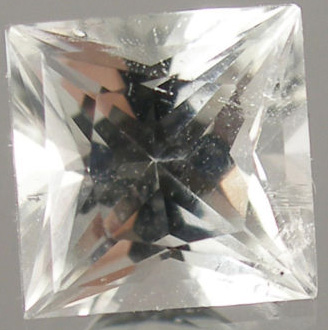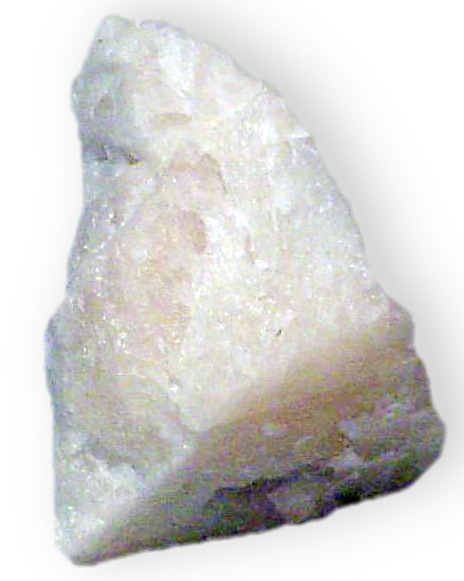Amblygonite
Amblygonite is a fluorophosphate mineral that also contains lithium, sodium and aluminium. It occurs in pegmatite veins and is found together with tourmaline, lepidolite, topaz, spodumene, apatite and other lithium minerals. Amblygonite has the chemical formula (Li,Na)AlPO4(F,OH) and has been mined commercially as a source of lithium.[1]

Amblygonite
(faceted, from Brazil. Weight: 0.8 carat)
Image © supplied by Woodmansee* Gems
Amblygonite is easily confused with quartz or albite from its appearance, however it can be distinguished by flame test, by the minerals it is found associated with, by its higher specific gravity or by its cleavage. The flame test is a commonly-used scientific test which can determine the presence of certain metals in a substance. It is performed by sprinkling a very small amout of powdered mineral into a hot flame (typically the blue flame setting of a laboratory burner) - and observing the color change in the flame. In the case of amblygonite, the flame turns pink-red; a positive test for the presence of lithium ions.
Amblygonite has four directions of cleavage - in comparision to quartz, which has none, and albite which has two at nearly 90º to each other. [2] Amblygonite's cleavage is perfect in one direction, good in two and distinct in the fourth. [3] It derives its name from the Greek words for blunt and angle owing to its 90º cleavage angle.
Amblygonite Varieties
Amblygonite occurs most commonly in white or cream color, but can also be "pastel shades" including yellow, lilac, pink, blue, beige, gray, brown, and green. In its pale yellow form it is possible to confuse with citrine, scapolite or golden beryl (aka. heliodor). [3]
Amblygonite is quite a common mineral found in numerous locations worldwide and is relatively inexpensive. It was first discovered in 1817. It can sometimes form very large crystals weighing several tons. [1] [5]
Amblygonite's lithium and sodium ions can substitute for each other and the amount of these two minerals can vary. Amblygonite also forms a solid solution series with montebrasite, with which it is often found in association. The structural composition of these minerals is the same and they are easily confused. [2]
As can be seen from the topmost image, amblygonite can somtimes occur in transparent form - and it has been faceted into a gemstone. However, owing to its vulnerability to breakage and abrasion it is not commonly set into jewelry. Gem quality amblygonite has been found in Brazil (Minas Gerais), Burma, the USA, Australia, France, Germany, Namibia, Norway, and Spain. [1] [2]
Amblygonite has been given the nickname "The Prophet Stone" and this suggests that in folklore the stone may have been used in divination as an aid to clarity of vision. [6]

Amblygonite rough
From South Dakota, USA
Amblygonite - Sources Referenced:
[1] http://en.wikipedia.org/wiki/Amblygonite
[2] http://www.galleries.com/minerals/phosphat/amblygon/amblygon.htm
[3] http://www.gemselect.com/other-info/amblygonite-gems.php
[4] http://www.handbookofmineralogy.org/pdfs/amblygonite.pdf
[5] http://www.associatedcontent.com/article/663917/discovering_the_gemstone_known_as_amblygonite.html
[6] http://www.ehow.com/how_2221167_use-amblygonite-energy.html
Back to the Gemstones List home page - over 160 gemstones explored!
Please feel free to link to this page - copy / paste the text below: (click to select)
Privacy Policy | Cookie Policy | GDPR | About This Site / Terms

© gemstoneslist.com


